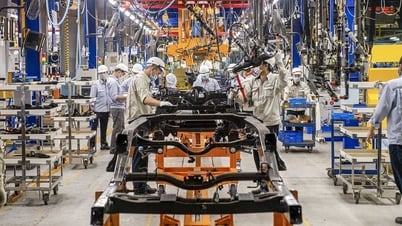 |
This year's shareholder meeting season witnessed a special highlight when a series of small-scale banks announced plans to increase capital and list shares on stock exchanges.
At the end of April 2025, VietABank approved a plan to increase its charter capital to more than VND 11,500 billion through issuing shares to existing shareholders at a maximum rate of 52.8%. At the same time, the bank also aims to list shares on HoSE or HNX.
Similarly, other banks have also approved plans to list their shares. For example, SaigonBank, with a total charter capital of VND3,100 billion, is expected to list its shares in the third quarter of 2025.
Meanwhile, KienlongBank has moved to HoSE and is expected to continue increasing its charter capital to nearly VND5,000 billion. BVBank has now been approved in principle for listing on HNX, increasing capital through private placement; and VietBank has also officially announced its plan to list on UPCoM in the coming months.
According to financial investors, the plans of small banks to list their shares on the stock exchanges will enrich their investment portfolios in the market and strengthen the leading role of banking and finance stocks.
Statistics show that by the end of the first quarter of 2025, banking stocks accounted for 40% of the VN-Index, and had a growth rate of 26% higher than stocks in other sectors, including real estate and construction materials, from the end of 2024 to present.
Experts at MSB Securities Company said that the entry of small-scale banks into the stock market will help increase liquidity and create new investment opportunities, especially in the context of investors looking for stocks with high growth potential.
For the banks themselves, listing their shares on the stock exchange will help them increase their access to new capital sources and make it easier to re-evaluate assets to restructure investment segments.
MBS Research believes that this year, the profit growth of listed banks is driven by a strong recovery in fee income and the acceleration of bad debt handling and recovery. Along with that, increasing charter capital through stock listing as the current market situation will help small banks improve their capital adequacy ratio (CAR), thereby being able to expand credit activities without putting pressure on increasing deposit interest rates.
Regarding the impact on the digital transformation process and restructuring of operating models, according to experts, listing shares on the stock exchange will also cause small-scale banks to reposition their market "niches" and invest deeply in digital technology development strategies, focusing on key and potential customer segments.
In fact, in recent times, to prepare for plans to create a "beautiful profile" before going public, small-scale banks have also focused on investing and cooperating in technology.
For example, in the first quarter of 2025, KienlongBank cooperated with large domestic and foreign partners and corporations to increase activities in the field of AI. The bank also launched the Kiloba AI application, tailored for KienlongBank staff, personalized for each staff, assisting in daily activities.
Several other banks have also pioneered in finding breakthrough solutions to catch up with the digital wave. For example, NCB has cooperated with Google Cloud to deploy the Data Lake system, AI/ML, upgrade the card core and build an integrated eKYC platform, helping customers easily open accounts online. Meanwhile, BVBank is currently leading the group of small-scale banks in terms of technology investment rate, reaching 26.06%; followed by ABBank with the investment rate for new technology reaching about 22.07%.
According to KBSV Securities Company, the preparation of small-scale commercial banks for listing at this time is to take advantage of the changes and destinations of large cash flows in the capital market. In the third quarter of 2025, it is likely that Vietnam's stock market will be upgraded. Impressive listings will help banks have more opportunities to attract foreign indirect capital, as it is estimated that about 4 - 6 billion USD will flow into Vietnam when the market is upgraded.
In addition, according to KBSV, in 2025, the State Bank expects the credit growth of the whole system to be 16% and is very active in promoting credit institutions to provide capital for key economic sectors, notably consumer credit, production and housing loans. When small commercial banks are listed on the stock exchange one after another, financial and investment data are made transparent; coupled with promoting credit growth, more cash will flow into groups of stocks closely related to bank loans, investment in production expansion, or stimulating consumption. From there, creating a spillover growth effect for both bank stocks and stocks of industry groups and businesses with strategic relationships with banks.
Source: https://thoibaonganhang.vn/ngan-hang-nho-tang-von-noi-tiep-len-san-niem-yet-163466.html


![[Photo] Prime Minister Pham Minh Chinh receives Country Director of the World Bank Regional Office for Vietnam, Laos, Cambodia](https://vphoto.vietnam.vn/thumb/1200x675/vietnam/resource/IMAGE/2025/5/15/2c7898852fa74a67a7d39e601e287d48)
![[Photo] In May, lotus flowers bloom in President Ho Chi Minh's hometown](https://vphoto.vietnam.vn/thumb/1200x675/vietnam/resource/IMAGE/2025/5/15/aed19c8fa5ef410ea0099d9ecf34d2ad)



![[Photo] President Luong Cuong attends the National Ceremony to honor Uncle Ho's Good Children](https://vphoto.vietnam.vn/thumb/1200x675/vietnam/resource/IMAGE/2025/5/15/9defa1e6e3e743f59a79f667b0b6b3db)




















![[Photo] Close-up of An Phu underpass, which will open to traffic in June](https://vphoto.vietnam.vn/thumb/1200x675/vietnam/resource/IMAGE/2025/5/15/5adb08323ea7482fb64fa1bf55fed112)




































































Comment (0)